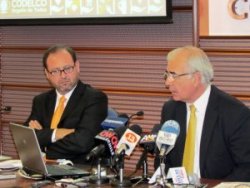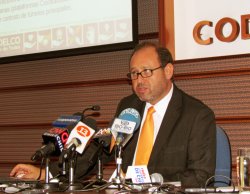Investors
CODELCO WILL INVEST MORE THAN 4.3 BILLION DOLLARS DURING 2012
More than 2.2 billion dollars are earmarked to boost mining projects in practically all of its operations, which means giving direct employment to 16 thousand people on average this year. If the investment program is fulfilled, annual copper production will increase by about 20% by 2020. “We are not here for petty squabbles,” responded the Executive President, Diego Hernández, when asked about Anglo American's advertising campaign.
Santiago, March 6, 2012.- Codelco will invest US$ 4,328 million during 2012, of which 2,273 million will be investments by the Vice Presidency of Projects (VP), responsible for managing and executing the Corporation's major development projects.
Codelco's CEO, Diego Hernández, reported that this investment amount "marks a new record in Codelco's history." Last year, the company invested US$2.545 billion, of which US$1.022 billion correspond to projects in the portfolio of the Vice Presidency of Projects. In this way, it is expected to advance in the development of Codelco's structural projects, of which Ministro Hales (US$1.145 billion) and Nuevo Nivel Mina El Teniente (US$399 million) are already under construction. Chuquicamata Subterranea, which is currently developing its feasibility study and executing early works, will have an expenditure of US$234 million. Finally, Expansión Andina 244, Explotación Sulfuros RT Fase II and San Antonio Óxidos will continue to advance in their feasibility engineering stages.

These five major projects will help maintain – and even increase – Codelco's production level, as well as improve its competitiveness. Hernández commented that in 2011 production reached 1.735 million metric tons of fine copper, but warned that this year it will be slightly lower, around 1.7 million tons. "Starting next year, production will begin to increase with the entry of the Ministro Hales mine at the end of the second half of the year. With these investments, by 2020 we will be above 2.1 million tons of fine copper," explained the CEO.
Strong increase in job creation
The company also reported that the execution of the projects will generate a significant number of direct jobs, which will benefit an average of 16,200 people. This represents a significant increase compared to 2011, when an average of 6,029 people were employed each month.
Regarding the financing of the investment plan, Diego Hernandez said that the company already has 2 billion dollars, which it raised last year in the international market through the issuance of bonds and bank loans. The executive announced that he hoped to raise a similar amount through amortization and own resources, in addition to waiting for the decision on the recapitalization of profits that the owner must make in June of this year. "We are financing this year with that," he said. Regarding the expected amount of capitalization, he refused to give a number, since "we propose and it is the owner who makes the decision."
Hernández also indicated that Codelco is working to address the shortage of professionals by developing a graduate program, which incorporates an average of 200 young professionals per year. In this way, the company's needs are met and generational change is ensured. Something similar occurs in the area of technicians, with the apprenticeship program.
On this subject, the CEO reported that Codelco is studying the possibility of establishing a training institution for underground mining in Calama, since Chuquicamata and then Ministro Hales are going to be transformed into underground mines. "We are trying to anticipate the need for people, we have a plan for that and it has gone well for us; but the most complicated area is the need for people for projects" he said.
Regarding the incorporation of women into mining, she mentioned that the company has special programs to increase female participation, which are proving to be successful. "In the graduate program, 20% are women, which is a higher participation than the average percentage of women in Codelco, which is only 8%. We are moving forward slowly, but we are moving forward well," she said.
Assessment and challenges for 2012
For his part, the Vice President of Projects, Sergio Fuentes, highlighted the progress made in the structural projects and especially in Ministro Hales (MH), which is in the execution stage: "One of the most relevant achievements is that we completed, within the 23-month period we had, the early works of the MH project. With an investment of 150 million dollars, it considered the drainage of the mine sector, the transfer of high-tension lines and electrical installations, large road works, the buildings that make up the civic neighborhood - polyclinic, offices and exchange house - and the mining truck workshop, with its mechanical and lubrication stations, among others."
He also added that during 2011 two projects were completed that are necessary for the operation of the Andina Division and its future expansion: the Río Blanco Diversion Tunnel and Water Normalization Stage I, which together amount to an investment of US$ 255 million.

Another important achievement of the VP's 2011 management was the safety with which the early works and projects were built, high-risk tasks since they include work with explosives, industrial assembly at geographic and physical heights, electrical and mechanical disciplines, among others. The results of this "commitment to life" were reflected in good indicators: with a total of 11 million 787 thousand hours worked and an average workforce of 6,029 workers, a Global Accident Frequency Index of 1.53 and a Global Severity Index of 40 were achieved, figures that are the best in the project industry.
Sergio Fuentes also stated that "our most important challenge for 2012 is to manage nearly 30 studies and projects that will impact all of the Corporation's divisions. And to execute the structural projects on time, at cost and with quality, and most importantly, without having to regret serious accidents, as we have been achieving over the last few years."
A significant challenge given the complexity of the global market for projects, with various simultaneous developments and a high demand for professionals, engineering, services and supplies.
Codelco – Anglo American conflict
Codelco CEO Diego Hernandez declined to comment on Anglo American's strategy of advertising its Legal Reports in the press through inserts. "We are not here for small fights; we are here for big fights, for the 49%," he said.
Asked about the possible influence of the campaign on justice, Hernandez said that "Chilean courts, justice and institutions are mature enough and have a long tradition to do their job impartially and not be subject to any kind of influence."
The executive insisted that the conflict is currently being handled in the judicial sphere "and that will take as long as it takes. There will be news as the trials develop and, probably, those trials will converge into one and that takes time." He added that, before January 31, "I can say that we were talking, not negotiating, through our advisors and their advisors. And if there had been something attractive, naturally a negotiation would have been initiated. The fact that we have not renewed the Confidentiality Agreement indicates that the judicial route is ultimately the one that prevails."
Explorations
The CEO reported that there is an increase in the budget for these activities, both within the national territory and abroad. "We are going to maintain much more aggressive exploration levels. We are carrying out explorations, especially in our foundational deposits, to increase reserves," he said.
Hernández said that approximately 20% of the budget for exploration will be invested abroad, mainly through partnerships. "Brazil, Ecuador and Colombia are the ones chosen to start and later we will see, depending on the results we have and the opportunities we can capture," he said.
Lithium mining
Regarding Codelco's foray into lithium production, Hernández commented that "it was not, in principle, part of our strategy to do so this year, but given all this concern we are reviewing whether we will have any interest in participating." In this regard, he explained that due to the characteristics of the company, it is not necessary to enter into the agreements contemplated by the new law.
The executive said that, currently, the lithium market is small compared to copper and that it is not Codelco's specialty. However, "if we look at the long term, the lithium market will increase in value and may be attractive; then we have to decide if we are interested and enter now, because if we don't, it probably won't be possible later," he concluded.
How major projects will progress in 2012
Ministro Hales: The Vice President of Projects stated that "in 2012 we expect to invest around 1.14 billion dollars in the Ministro Hales project, which is the first to come into operation, towards the second half of next year. MH is currently developing the prestripping of the mine and we have all the construction contracts assigned, with physical progress in the crushing, grinding and flotation plants, the roasting complex and the sulfuric acid and arsenic abatement plants."
New Mine Level – El Teniente: The New Mine Level – El Teniente project, which obtained approval for its Environmental Impact Study (EIA) and investment authorization in 2011, is currently completing the construction of its early works, including the platforms in Confluencia, where the new accesses to the mine will be located. In addition, at the beginning of this year the execution phase of the project itself began, both from inside the mine and from the surface.
Chuquicamata Underground Mine: Last year, this structural project obtained the approval of the Board of Directors to carry out its early works, which were favorably recommended by Cochilco – Mideplan. Currently, along with progress on the feasibility study, the works that constitute the "critical route" of the project have begun. With an investment of US$ 850 million, the early works of Chuqui Underground include a series of earthworks and large excavations, such as tunnels for the access of workers and for the transportation of mineral, shafts and galleries for the injection of clean air and the extraction of stale air, mine ramps and other support works, such as water, energy, telecommunications networks and part of the industrial district.
Andean Expansion 244: The Andean Expansion 244 project has made progress in two subprojects that constitute part of its early works – Acid Water Treatment and Node 3,500 – and should conclude its feasibility study by the end of 2012.
Radomiro Tomic Sulfides Exploitation Phase II: This is Codelco's fifth structural project and involves exploiting the Radomiro Tomic mine's sulfide reserves in a new concentration plant - which will use desalinated seawater. The project concluded its pre-feasibility stage in 2011 and is tasked with developing the complete feasibility phase during this year.
San Antonio Oxides, Salvador Division: US$57 million is expected to be invested to begin construction during the third quarter of this year.
Communications Department
* For photographs see http://www.flickr.com/photos/codelco
Downloadable files
Order by: